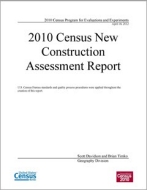2010 Census New Construction Assessment Report
2010 Census New Construction Assessment Report
Executive Summary
The 2010 New Construction program was an integral part of the 2010 Census activities that utilized the expertise of tribal and local governments to improve the accuracy and completeness of the address list used to take the census. The purpose of the program was to account for new housing units built after the 2010 Census Address Canvassing Operation was completed.
This assessment documents the results of the program focusing on the following components:
- Invitation and registration
- Characteristics of addresses and returns
- Detailed processing results
- Schedule deviations
- Help Desk call statistics
- Lessons learned
The U.S. Census Bureau enlisted government participation by inviting the highest elected officials from the 28,683 eligible jurisdictions to participate in the program.
Nearly 21 percent of eligible governments participated in the program. To assist in assigning Census tract and block codes (also known as “geocoding”) for each submitted address, forty-one percent of registrants selected Portable Document Format maps and 59 percent of registrants selected shapefile data.
Of the 5,952 entities that registered, 44 percent or 2,634 returned submissions. Only two percent of submissions were unusable, therefore all other submissions were usable or usable after Regional Census Center staff reviewed them and worked with participants to resolve problems as needed.
Lower level governments such as American Indian Reservations, Places, and Minor Civil Divisions had a higher percentage of submitted new and unmatched addresses than counties. Governmental size played a factor on the enumeration success of New Construction addresses. The smaller the governmental entity the more likely the address that entity submitted would be found and enumerated.
Of the 503,489 addresses submitted for New Construction, a total of 291,627 addresses were sent to enumeration. Of the addresses sent to enumeration, 117,287 addresses were enumerated in the 2010 Census.
The 2010 New Construction program had only minor schedule deviations. Of the 26 high-level activities, 18 activities started on time or earlier and 19 activities finished on time or earlier. The scheduled activity with the largest deviation was related to obtaining clearance from the Office of Management and Budget to conduct the operation, which started 32 days late.
The help desk for the 2010 New Construction program handled 1,099 incoming calls from participants. Of the incoming calls, 994 calls were handled by the Help Desk and the remaining calls were transferred to Regional Census Centers or Census Bureau headquarters staff for appropriate resolutions.
The Decennial Management Division organized multiple lessons learned sessions in order to gather information regarding aspects of program efficacy and areas needing improvement for future New Construction programs. Stakeholders from Geography Division, Field Division, and the contractor staff from the Geographic Partners hip Programs Technical Help Desk participated in these sessions. From these lessons learned sessions, Decennial Management Division compiled a document of lessons learned that included the issues being discussed as well as any potential resolutions or recommendations.
For future New Construction programs, there are three recommendations. Encourage governments at the lowest level to either participate or work with larger governments to consolidate their submissions in order to in crease the quality of data received for New Construction programs. Communicate and design partnership programs with government size in mind. Update the Master Address File through partnership programs in order to increase the Census Bureau’s ability to geocode addresses from the United States Postal Service Delivery Sequence File.
Others in Series
Publication
Publication
Publication




